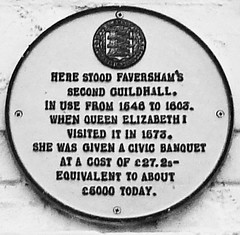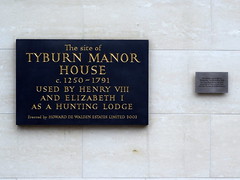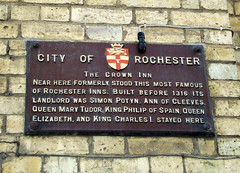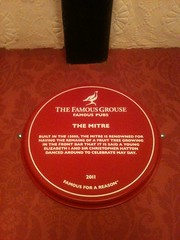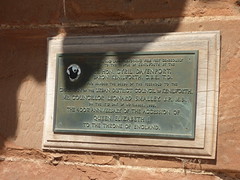Queen Elizabeth I of England


Queen Elizabeth I of England
(1533-1603)
woman and Queen of England (1558-1603)
Family tree
Commemorated on 12 plaques
George Hotel Late medieval inn Queen Elizabeth I was received here in 1573
Stone Street, Cranbrook, United Kingdom where they was received (1573)
Here stood Faversham's second guildhall. In use from 1546 to 1603. When Queen Elizabeth I visited it in 1573 she was given a civic banquet at a cost of £27.2s- equivalent to about £5000 today.
Faversham's second guildhall, Court Street, Faversham, United Kingdom where they visited (1573)
Site of Elsynge Hall in which stayed Edward VI and Elizabeth I as children
On excavation site, Forty Hall estate, Enfield, London, United Kingdom where they stayed
The site of Tyburn Manor House c. 1250 - 1791 Used by Henry VIII and Elizabeth I as a hunting lodge
Marylebone High Street, London, United Kingdom where they used as a hunting lodge
The Crown Inn Near here formerly stood this most famous of Rochester inns. Built before 1316 its landlord was Simon Potyn. Ann of Cleeves, Queen Mary Tudor, King Philip of Spain, Queen Elizabeth, and King Charles I. stayed here
Gundulph Sq, Rochester, United Kingdom where they stayed
On this site was built the Davies Amphitheatre 1662-1682 the last bear-baiting ring of Bankside visited by Samuel Pepys and John Evelyn. To the north from mid 16th century was the Bear Gardens, a bear-baiting ring visited by Queen Elizabeth I and replaced by The Hope Playhouse 1614-1656, built for plays and bear-baiting where Ben Jonson's play 'Bartholomew Fair' was first performed
Bear Gardens, SE1, London, United Kingdom where they visited
The Mitre Built in the 1500s, The Mitre is renowned for having the remains of a fruit tree growing in the front bar that is said a young Elizabeth I and Sir Christopher Hatton danced around to celebrate May Day
1 Ely Court, Farringdon, EC1N 6SJ, London, United Kingdom where they was
Sandgate Castle. Commissioned for Henry VIII. Built 1539. Queen Elizabeth I rested here 28 August 1575. Queen Victoria and the Prince Consort visited 9 August 1855.
Castle Road, Sandgate, United Kingdom where they was
The Free Grammar School of Elizabeth Queen of England founded 1585
Old Grammar School - Church Street, Ashbourne, United Kingdom where they founded a school (1584)
This gateway is the only remaining portion of the Whitefriars 1285-1539. Richard II held a council and lodged here in 1392. Queen Elizabeth was entertained here in 1565 by the Lord Treasurer Burghley
Uffington Road, Stamford, United Kingdom where they was entertained (1565)
This Castle and lands adjoining were very generously given to the people of Kenilworth by the Rt. Hon Cyril Davenport, Baron Kenilworth, C.B.E., T.D., who handed the deeds of the freehold to the Chairman of the Urban District Council of Kenilworth, Mr. Councillor Leonard Smalley, J.P., M.B., on the 11th day of November, 1958, The 400th anniversary of the accession of Queen Elizabeth I to the throne of England.
Near the Great Hall - Kenilworth Castle, Kenilworth, United Kingdom where they commemorated on the 400th anniversary of the accession (1958)
The Grammar School Originally granted to the town by Elizabeth I in 1551 the school, now a parish hall, was re-built during the reign of Queen Anne.
Church Side, Mansfield, United Kingdom where they was


